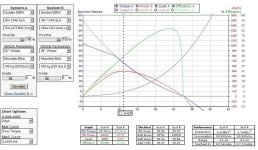Most members respect the
ebikes.ca "Hub Motor and Ebike Simulator".
I thought it would be appropriate to use it to
test the eBike "watt rating" theories.
1. open ebike calculator in separate window
right click, "Open link In New Window",
here
2. "Open System B"
3. Configure all factors identically
Golden 500W = (500w rated)
36V 12Ah SLA
except Controllers
System A = 35a
System B choose custom and set to 100a
(or 75a) added - beyond 75a controller contributes absolutely nothing!
4. click "Simulate"
PS I set
"mph" under "Chart Options"
 Things to notice:
Things to notice:
At 12mph full throttle both output at the maximum 500w, efficiency is at 50%, so ... 1000w input for 500w output.
Going from 35a to 100a controller (red lines) shows only a fractional-minimal power increase, and only at the bottom of the power curve. (A maximum 500w output from a 36V 100a controller, a potential 3600w input!)
At 1mph
35a controller uses 1219 electric watts to produce 68w output watts & 1151 watts of damaging heat
75-100a controller uses 2208w electric watts to produce 94w output watts & 2114 watts of damaging heat
At 5mph
35a controller uses 1056 electric watts to produce 280w output watts & 776 watts of damaging heat
75-100a controller uses 1626w electric watts to produce 360w output watts & 1266 watts of damaging heat
Continuous run (full throttle) "breakpoint" occurs at (700w input 450w output or
250w continuous heat dissipation.)
"Continuous run input wattage" is not a limitation, rather, continuous-average wasted wattage (heat) is.
Avoiding damaging heat production?
Moderate amp input at low speeds (limited throttle or wimpy controller if you have no self control.) or ...
Limit time at low speed - substantial pedal assist getting up to efficient speed.
Combined - pedal assist with moderate throttle recommended!
Get a good run at hills, continuous pedal assist and finally, reduce throttle as speed decreases.
0% additional contribution beyond a 75a controller.
Golden 500W @ 36V looks pimped for the US market with a precise 20mph capability!
Notice the shift in efficiency produced by varying the throttle percentage!
Throttle reduction mimics lower voltage, or effectively reduces voltage to motor.
(Seemingly negating some advantages I envisioned for a 22 > 44V "shift".)
Last effort at trying to explain-prove watt rating-usage ...
so please don't criticize my views until trying the ebikes.ca "Hub Motor and Ebike Simulator", as described above ---
DrkAngel

